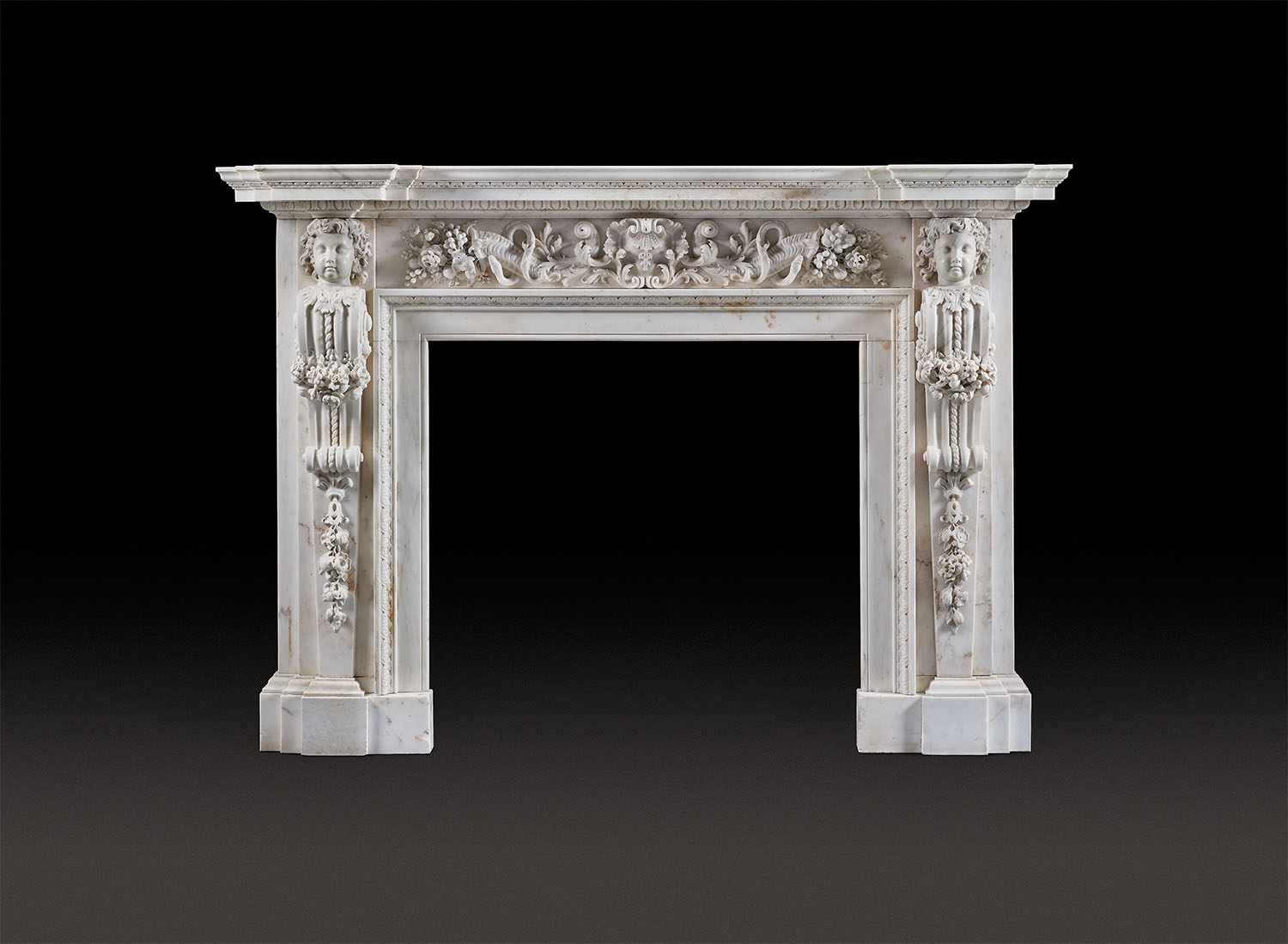
G286 (Sold)
A Resplendent and Rare Palladian Chimneypiece, of Kentian Style and Period
A magnificent and rare antique George II, Palladian, Kentian style and period statuary marble fireplace. Circa 1740.
The breakfront shelf with cyma reversa mouldings decorated with acanthus leaf and 'egg and dart,’ reminders of ancient Roman architecture and of course, good and evil, above a frieze with a central cartouche of an overlapped scallop shell an attribute of Venus, the Goddess of love and fertility, flanked by cornucopiae, horns of plenty, each entwined with writhing snakes and scrolling acanthus. Their open mouths overflowing with the earth's bounty, fruits including apples, plums and grapes and full blown flowers, both the horns and snakes are attributes of Ceres the Goddess of agriculture and abundance. The jambs are in the form of terms on tapering pedestals decorated with inverted flower pendants above are elongated S-shaped console brackets with heavy swags of well carved flowers and fruits tied to the volutes on the sides. These are capped by busts of the young God Mercury (Gk. Hermes) the messenger of the Gods wearing acanthus foliate collars. In classical antiquity Terms/Herms stood in doorways and gardens to protect orchards and vineyards and to mark distances and boundaries. The opening is framed by plain panels with acanthus leaf mouldings. The whole raised on footblocks.
The design drawing and decoration of this beautifully executed chimneypiece gives it a strong sense of sculptural monumentality and robustness so typical of the Palladian style as interpreted by Inigo Jones (1573–1652) and further embellished in the early 18th century by England's 'high-priest' of the visual arts William Kent (1685–1748) under the aegis of the 'Apollo of the Arts', Lord Burlington (1694–1753) whose mission was to reinstate Roman architecture as described by Vitruvius and practised by Palladio and Scamozzi and to end the empirical baroque of Wren and his school. By the 1720/30s the Palladain movement had become firmly established and was highly fashionable. Radical though it was, it had appealed to the fabulously wealthy aristocracy who were natured on classical literature and were very keen to embrace emancipation from contemporary European taste and Palladainism became established as the accepted style for the exterior and interior of country houses and public buildings.
Kent’s chimneypieces were designed for important grand state rooms, opulent showcases of power and might, reflecting the growing confidence in England in its governance, military prowess and freedoms; and as the central and focal point of a room always have a bold imposing appearance, a richness and restrained voluptuousness with a three dimensional solidity. In his adapted Jonesian designs a characteristic treatment for furniture as well is the use of scroll consoles or terms sometimes used in profile; examples are to be found at Houghton Hall, Norfolk, the finest Palladian interior in England and the most complete embodiment of the Palladian mission to recreate the glories of ancient Roman architecture on England's soil.
English marble chimneypieces of this quality were executed by the most experienced and capable sculptors who were all London based; Kent's favoured chimneypiece sculptor was the Hyde Park based workshop of Joseph Pickford (1684–1762). He worked with Burlington's sculptor the Italian, Giovanni Guielfi restoring the ancient Arundel Marbles and both were well known in the inner Palladian circles.
Provenance: Ranton Abbey, Staffordshire
Accidentally burned and gutted in 1942 when troops from Queen Wilhelmina's bodyguard were billeted there. The house was built by Viscount Thomas Anson (1695–1773) later Earl of Litchfield, circa 1820, next door to the picturesque ruins of the abbey; his main seat was Shrugborough. Due to heavy gambling debts he left England no doubt to escape his creditors and returned after selling most of the contents of Shrugborough and his London house and resided at Ranton. Where the chimney piece was prior to 1820/1840 we have been unable to ascertain and can only speculate.
T Crowther & Sons, Northend Road, London. Advertised in 'Connoisseur' Oct. 1978.
Sothebys N.Y. Property from an important private collector, Oct. 1999. Sold. (Provenance as coming from Ranton Abbey and T Crowther).
Height 66¼in (168.2cm) width 94in (238.6cm)
Internal height 46¾in (118.5cm) width 49in (124.5cm)






